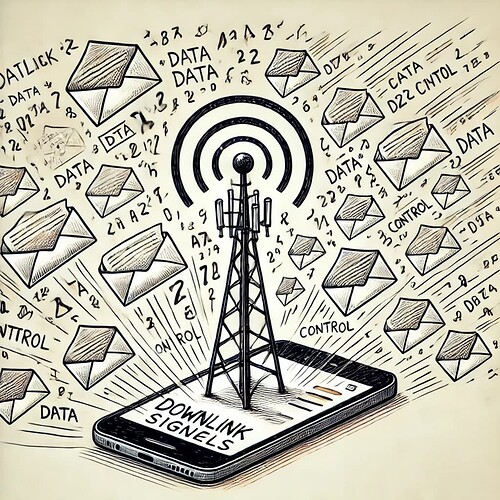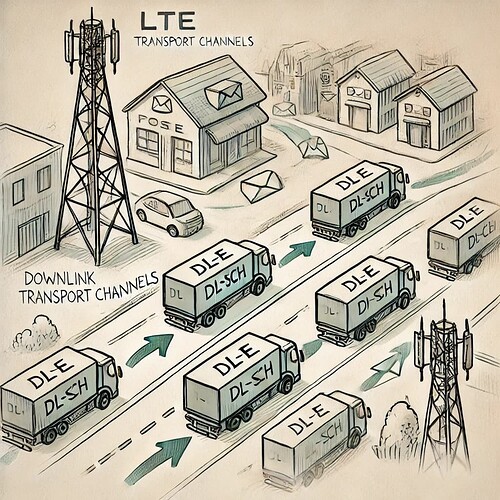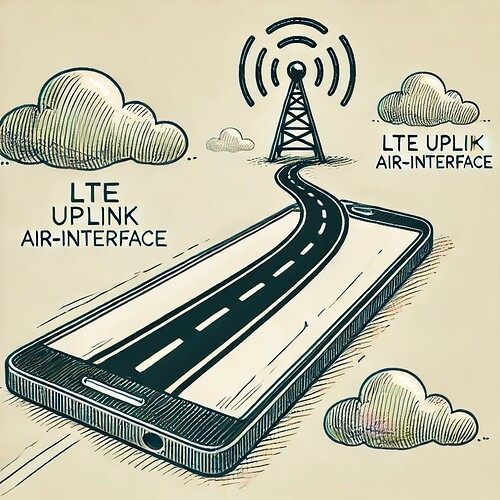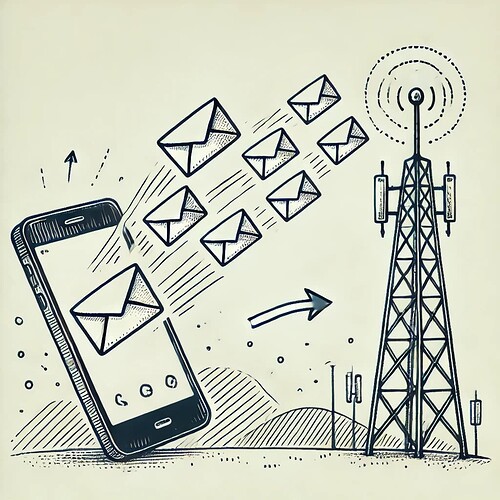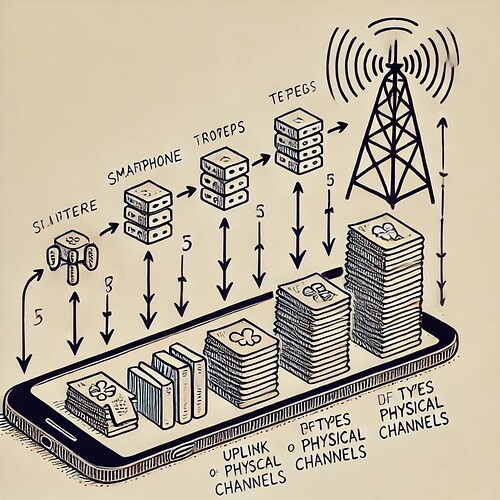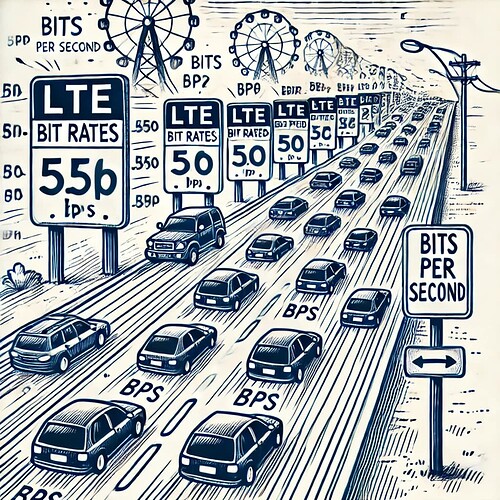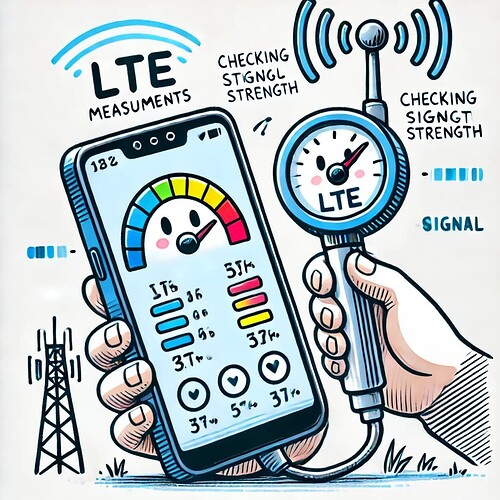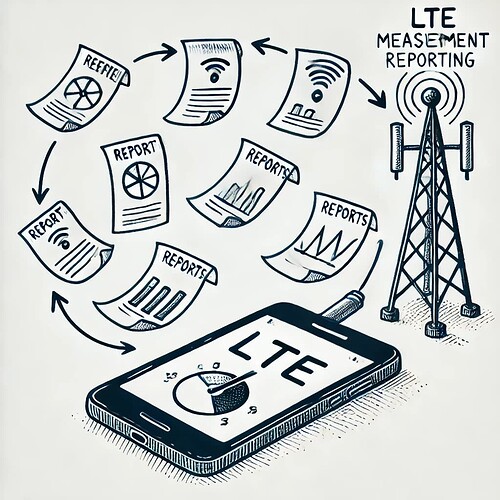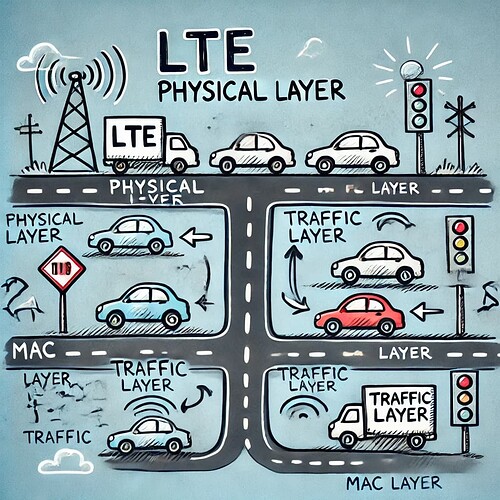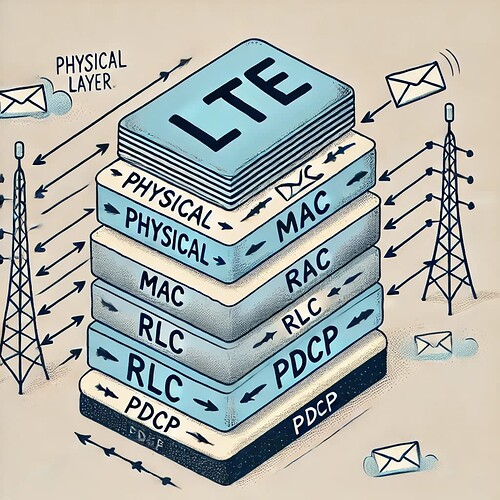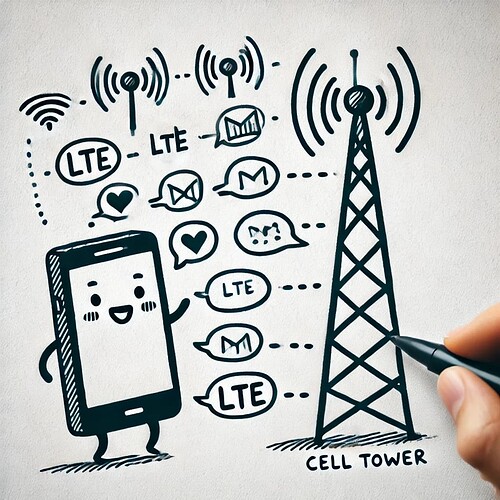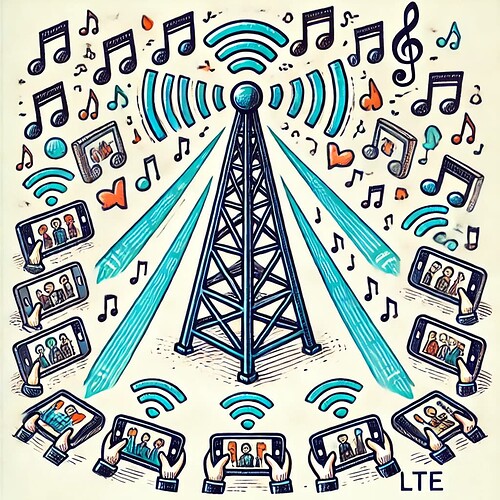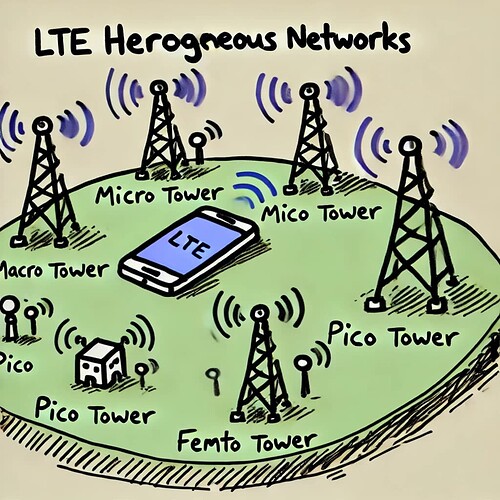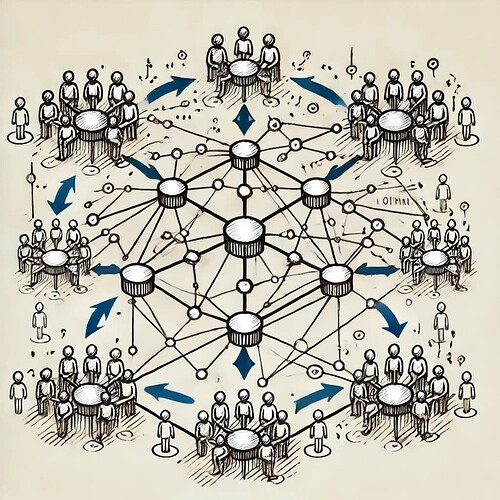This topic presents in a very simplified way all the main concepts that should be understood by those who know LTE.
Overview
LTE (Long-Term Evolution) is a technology designed to provide faster mobile broadband services by improving how data is sent and received between mobile devices and network towers.
It uses a combination of advanced technologies to make mobile communication faster, more reliable, and efficient, with improvements on both the user and network sides.
![]() LTE helps your phone connect to the internet and make calls faster and more reliably by using advanced technologies and constantly improving how it sends and receives data.
LTE helps your phone connect to the internet and make calls faster and more reliably by using advanced technologies and constantly improving how it sends and receives data.
Skip to: Roadmap
- Fundamentals
 sections
sections - Downlink Air-Interface
 sections
sections - Downlink Multiple Antenna Technologies
 sections
sections - Downlink Signals
 sections
sections - Downlink Physical Channels
 sections
sections - Downlink Transport Channels
 sections
sections - Downlink Channel Type Mappings
 sections
sections - Downlink Control Information
 sections
sections - System Information
 sections
sections - Uplink Air-Interface
 sections
sections - Uplink Multiple Antenna Technologies
 sections
sections - Uplink Signals
 sections
sections - Uplink Physical Channels
 sections
sections - Uplink Transport Channels
 sections
sections - Uplink Channel Type Mappings
 sections
sections - Uplink Control Information
 sections
sections - Carrier Aggregation
 sections
sections - UE Capabilities
 sections
sections - Bit Rates
 sections
sections - Measurements
 sections
sections - Measurement Reporting
 sections
sections - Idle Mode Procedures
 sections
sections - Physical and MAC Layer Procedures
 sections
sections - Protocol Stacks
 sections
sections - Signaling Procedures
 sections
sections - Voice Services
 sections
sections - Multimedia Broadcast Services
 sections
sections - Coordinated Multi-Point Transmission
 sections
sections - Heterogeneous Networks
 sections
sections - Network Planning
 sections
sections - Self-Organizing Network (SON)
 sections
sections - UE Identities
 sections
sections
Fundamentals
LTE is a mobile communication standard that enhances data speeds, network efficiency, and coverage. It uses both downlink (from the network to the user device) and uplink (from the user device to the network) technologies to achieve this.
![]() An easy way to understand LTE is to make an analogy with a city, with streets, neighborhoods, etc.
An easy way to understand LTE is to make an analogy with a city, with streets, neighborhoods, etc.
- Search Forum
 LTE
LTE 
Downlink Air-Interface
This is the pathway through which data is transmitted from the network to the user’s device. It defines how the signals travel and are received by the device.
The downlink air-interface refers to the communication link from the cell tower to the user’s device.
![]() It’s the road that goes from the cell tower to your phone.
It’s the road that goes from the cell tower to your phone.
- Search Forum
 LTE Downlink Air-Interface
LTE Downlink Air-Interface 
Downlink Multiple Antenna Technologies
This involves using multiple antennas to send signals to user devices, increasing the amount of data sent at the same time for better speed and performance.
Technologies like MIMO (Multiple Input Multiple Output) use multiple antennas to improve data transfer rates and reliability.
![]() Using several antennas at once so data gets to you faster and without interruptions.
Using several antennas at once so data gets to you faster and without interruptions.
- Search Forum
 LTE Downlink Multiple Antenna Technologies
LTE Downlink Multiple Antenna Technologies 
Downlink Signals
These are the signals transmitted from the base station to the user’s device. They carry information that enables communication between the network and the device, like data, control information, and more.
![]() These are like letters that the cell tower sends to your phone.
These are like letters that the cell tower sends to your phone.
- Search Forum
 LTE Downlink Signals
LTE Downlink Signals 
Downlink Physical Channels
These are specific radio frequencies where the actual data travels from the base station to your phone.
Physical channels are the actual paths that carry information over the air, such as PDSCH (Physical Downlink Shared Channel).
![]() These are the paths that the letters travel through the air.
These are the paths that the letters travel through the air.
- Search Forum
 LTE Downlink Physical Channels
LTE Downlink Physical Channels 
Downlink Transport Channels
These channels carry data over the air between the Radio network and the Core network, including the DL-SCH (Downlink Shared Channel).
![]() These are like the trucks that carry letters from the post office to the cell tower.
These are like the trucks that carry letters from the post office to the cell tower.
- Search Forum
 LTE Downlink Transport Channels
LTE Downlink Transport Channels 
Downlink Channel Type Mappings
This refers to how different types of data (control, user data) are mapped onto the physical channels so they can be efficiently transmitted.
![]() It’s like organizing different types of letters (data and control) into the right trucks.
It’s like organizing different types of letters (data and control) into the right trucks.
- Search Forum
 LTE Downlink Channel Type Mappings
LTE Downlink Channel Type Mappings 
Downlink Control Information
It consists of important instructions sent from the network to guide the device on how to receive and process the signals.
Information necessary for the device to understand how to receive and decode data, including scheduling information.
![]() It’s the part of the letter that explains how to read and understand the message.
It’s the part of the letter that explains how to read and understand the message.
- Search Forum
 LTE Downlink Control Information
LTE Downlink Control Information 
System Information
Information broadcasted by the network to all devices, such as network configuration and cell identifiers.
This includes key details that the network sends to devices about how the network operates and how devices can connect and communicate.
![]() Information broadcast by the network to all devices, like road signs that all cars (phones) need to see.
Information broadcast by the network to all devices, like road signs that all cars (phones) need to see.
- Search Forum
 LTE System Information
LTE System Information 
Uplink Air-Interface
Just like the downlink, the uplink is the path for data sent from the user’s device back to the network.
The uplink air-interface refers to the communication link from the user’s device to the cell tower.
![]() The road that goes from your phone to the cell tower.
The road that goes from your phone to the cell tower.
- Search Forum
 LTE Uplink Air-Interface
LTE Uplink Air-Interface 
Uplink Multiple Antenna Technologies
These are similar to downlink antenna technologies but work in the reverse direction, allowing devices to send more data to the network using multiple antennas.
Techniques like MU-MIMO (Multi-User MIMO) improve uplink performance by using multiple antennas.
![]() Using several antennas to send data faster from your phone to the tower.
Using several antennas to send data faster from your phone to the tower.
- Search Forum
 LTE Uplink Multiple Antenna Technologies
LTE Uplink Multiple Antenna Technologies 
Uplink Signals
These are the signals sent from the user’s device to the network, allowing the device to communicate with the base station.
Signals sent from the user’s device to the cell tower, including data and control information.
![]() These are the letters your phone sends to the cell tower.
These are the letters your phone sends to the cell tower.
- Search Forum
 LTE Uplink Signals
LTE Uplink Signals 
Uplink Physical Channels
Like downlink, uplink physical channels are the specific radio frequencies that carry data from the user’s device to the network.
Actual paths for uplink data, such as PUSCH (Physical Uplink Shared Channel).
![]() The paths in the air that your phone’s letters travel to the tower.
The paths in the air that your phone’s letters travel to the tower.
- Search Forum
 LTE Uplink Physical Channels
LTE Uplink Physical Channels 
Uplink Transport Channels
These transport data from the user device to the network, making sure it reaches the correct location.
Channels that carry data from the user’s device to the network, such as UL-SCH (Uplink Shared Channel).
![]() Trucks that carry the letters from your phone to the cell tower.
Trucks that carry the letters from your phone to the cell tower.
- Search Forum
 LTE Uplink Transport Channels
LTE Uplink Transport Channels 
Uplink Channel Type Mappings
This refers to how different types of data are connected to the right physical and transport channels for transmission.
How different types of uplink data are assigned to physical channels.
![]() Organizing different types of letters that your phone sends.
Organizing different types of letters that your phone sends.
- Search Forum
 LTE Uplink Channel Type Mappings
LTE Uplink Channel Type Mappings 
Uplink Control Information
These are instructions sent by the device to the network, guiding it on how to receive and interpret the signals from the device.
Information the device sends to the network to help manage uplink data transmission.
![]() Parts of the letters from your phone that help the tower understand the messages.
Parts of the letters from your phone that help the tower understand the messages.
- Search Forum
 LTE Uplink Control Information
LTE Uplink Control Information 
Carrier Aggregation
This is a feature that allows LTE to combine multiple frequency bands, making data transfer faster by using more bandwidth.
Combining multiple frequency bands to increase data rates and network efficiency.
![]() Using multiple lanes of the highway to increase internet speed.
Using multiple lanes of the highway to increase internet speed.
- Search Forum
 LTE Carrier Aggregation
LTE Carrier Aggregation 
UE Capabilities
UE (User Equipment) capabilities refer to what a user’s device can do in terms of communication with the network, like how fast it can download or how many antennas it can use.
UE capabilities are like supported frequency bands and data rates.
![]() What your phone can do, like which lanes of the highway it can use.
What your phone can do, like which lanes of the highway it can use.
- Search Forum
 LTE UE Capabilities
LTE UE Capabilities 
Bit Rates
This is the speed at which data is transmitted, measured in bits per second. Higher bit rates mean faster data speeds.
The amount of data transmitted per second, measured in bits per second (bps).
![]() The speed at which data travels on the highway, measured in bits per second.
The speed at which data travels on the highway, measured in bits per second.
- Search Forum
 LTE Bit Rates
LTE Bit Rates 
Measurements
These are checks performed by the network and device to ensure a strong signal and efficient communication.
Assessing signal strength and quality to maintain a reliable connection.
![]() Checking the signal strength to keep a good connection.
Checking the signal strength to keep a good connection.
![]() Checking LTE signal strength to maintain a reliable connection.
Checking LTE signal strength to maintain a reliable connection.
- Search Forum
 LTE Measurements
LTE Measurements 
Measurement Reporting
Devices send reports to the network to help it make decisions about signal strength, data handling, and resource allocation.
Devices send reports on signal quality to the network to optimize performance.
![]() Your phone sends reports about signal strength to the tower to adjust the connection.
Your phone sends reports about signal strength to the tower to adjust the connection.
- Search Forum
 LTE Measurement Reporting
LTE Measurement Reporting 
Idle Mode Procedures
This defines how devices behave when they are not actively using the network but are still connected, such as how they conserve battery power.
Procedures for when a device is not actively transmitting data, like cell selection and reselection.
![]() What your phone does when it’s not sending or receiving data, like looking for the best tower.
What your phone does when it’s not sending or receiving data, like looking for the best tower.
- Search Forum
 LTE Idle Mode Procedures
LTE Idle Mode Procedures 
Physical and MAC Layer Procedures
The physical layer refers to the actual transmission of radio signals, while the MAC (Medium Access Control) layer controls how data packets are sent and received in an orderly manner.
Physical layer involves actual data transmission, while the MAC layer manages access to the network.
![]() The physical layer is the road, and the MAC layer manages the traffic on the road.
The physical layer is the road, and the MAC layer manages the traffic on the road.
- Search Forum
 LTE Physical and MAC Layer Procedures
LTE Physical and MAC Layer Procedures 
Protocol Stacks
These are the layers of communication protocols that allow devices to exchange data with the network. Each layer handles a specific aspect of the communication process.
Layers of protocols that manage data transmission, including physical, MAC, RLC, and PDCP layers.
![]() Sets of rules that help organize how data is sent and received.
Sets of rules that help organize how data is sent and received.
- Search Forum
 LTE Protocol Stacks
LTE Protocol Stacks 
Signaling Procedures
Signaling involves messages exchanged between the network and devices to control communication, like setting up a call or sending data.
Communication between the device and network to manage connections and data flow.
![]() How your phone and the cell tower talk to keep the connection working.
How your phone and the cell tower talk to keep the connection working.
- Search Forum
 LTE Signaling Procedures
LTE Signaling Procedures 
Voice Services
Although LTE is primarily for data, it also supports voice services through technologies like VoLTE (Voice over LTE), which allows high-quality voice calls over the LTE network.
Techniques to provide voice communication over LTE, like VoLTE (Voice over LTE).
![]() How to make voice calls using LTE internet, like VoLTE.
How to make voice calls using LTE internet, like VoLTE.
- Search Forum
 LTE Voice Services
LTE Voice Services 
Multimedia Broadcast Services
LTE also supports broadcasting multimedia content, allowing things like live TV streaming to multiple users at the same time.
Broadcasting multimedia content to multiple users simultaneously.
![]() Broadcasting videos and music to many people at the same time.
Broadcasting videos and music to many people at the same time.
- Search Forum
 LTE Multimedia Broadcast Services
LTE Multimedia Broadcast Services 
Coordinated Multi-Point Transmission
This improves signal quality by coordinating multiple base stations to work together when sending data to a device, especially in areas with poor signal.
Multiple cell towers coordinate to improve data rates and coverage.
![]() Multiple cell towers working together to improve the connection.
Multiple cell towers working together to improve the connection.
- Search Forum
 LTE Coordinated Multi-Point Transmission
LTE Coordinated Multi-Point Transmission 
Heterogeneous Networks
These networks combine different types of cells (like large towers and small cells) to provide better coverage and capacity.
Using a mix of cell types (macro, micro, pico, femto) to improve coverage and capacity.
![]() Using different types of cell towers to improve coverage.
Using different types of cell towers to improve coverage.
- Search Forum
 LTE Heterogeneous Networks
LTE Heterogeneous Networks 
Network Planning
This involves strategically designing and implementing LTE networks to ensure good coverage, capacity, and performance in a given area.
Designing and optimizing the network to ensure efficient coverage and performance.
![]() Planning where to place cell towers so everyone has a good connection.
Planning where to place cell towers so everyone has a good connection.
- Search Forum
 LTE Network Planning
LTE Network Planning 
Self-Organizing Network
These networks use automation to adjust and optimize performance in real time, ensuring that the LTE network always runs efficiently without human intervention.
Networks that automatically optimize their configuration and operation for better performance.
![]() Networks that adjust themselves to work better without much human help.
Networks that adjust themselves to work better without much human help.
- Search Forum
 LTE Self-Organizing Network
LTE Self-Organizing Network 
UE Identities
LTE organizes data transfer and communication between user devices and the network, focusing on efficiency, security, and resource management through a series of unique identifiers and protocols. By assigning each device distinct temporary and permanent identifiers, LTE ensures secure connections, optimal resource allocation, and seamless transitions across network areas.
![]() Imagine LTE as a well-organized city with residents who each have unique identity passes. Some passes change depending on where they are in the city, allowing for both privacy and easy management, while other IDs remain permanent. This setup ensures smooth movement, secure access, and reliable communication across various neighborhoods (network areas).
Imagine LTE as a well-organized city with residents who each have unique identity passes. Some passes change depending on where they are in the city, allowing for both privacy and easy management, while other IDs remain permanent. This setup ensures smooth movement, secure access, and reliable communication across various neighborhoods (network areas).
![]() LTE UE Identities illustrated as a phone wearing multiple ‘city pass’ badges for both permanent and temporary identifiers, set against network structures symbolizing secure and organized connections.
LTE UE Identities illustrated as a phone wearing multiple ‘city pass’ badges for both permanent and temporary identifiers, set against network structures symbolizing secure and organized connections.
- Search Forum
 LTE UE Identities
LTE UE Identities 
That’s it. ![]()
- Continue reading: Roadmap to LTE - Fundamentals
- Or back to: Roadmap to LTE



